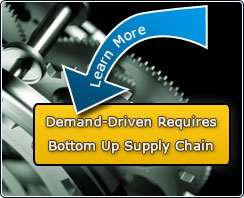How To Get Rid of your Planners Once and for all
Attendance for our meeting included the CIO, Chief Merchant, Director of Forecasting, planners, and inventory management people. They told us their goals were to reduce operating capitol but maintain service levels for the web and store customers. The company wanted to increase turns while re-purposing the capital from inventory into new stores and acquisitions. The irony of the meeting is that while they used words like Demand Driven retail and Demand Forecasting, they were really talking about planning and goal setting. They believed that allocations were great and had never even thought of discussing top down versus bottom up as two distinctly different methodologies that are used to achieve entirely different goals.
Failing to Forecast on Demand, Planning to Fail
The planners and then chief merchant brought the discussion to a freeze when the chief merchant specifically asked me this question: “How does your system fix the Demand Forecast when the Demand Forecasting doesn’t fit the plan?”
The Differences among Forecast, Plan, and Goal
Dr. John T. Mentzer (bio) is one of the foremost authorities on supply chain management. Among his popular writings is a short brief titled: “The Seven Keys to Better Forecasting” which outlines how to develop a competitive differentiation in Demand Forecasting and Planning. He highlights the issue no one wants to discuss: most people do not understand what Demand Forecasting IS and IS NOT. The results have created a significant issue: the Blurring of the distinction between forecasts, plans, and goals.
- Understand what forecasting is and is not
- Issue: Blurring of the distinction between forecasts, plans, and goals
- Action: Derive plans from forecasts and distinguish between forecasts and goals
- Result: An environment in which forecasting is acknowledged as a critical business function, accuracy is emphasized, and game-playing is minimized
- Forecast demand, plan supply
- Communication, cooperation, and collaboration
- Eliminate islands of analysis
- Use tools wisely
- Make it Important
- Measure, measure, measure
Sources: The Seven Keys to Forecasting and The Impact of Forecasting on Return on Shareholder’s Value
Start with Demand Forecasting and then Plan
And now, back to our Chief Merchant…
I would like to think he meant something like: “We have a new product and I want to spend 2 million on the initial inventory. If your system says the model should be 1.5M, does the system have tools to raise the inventory to meet the initial planners ‘suggestion?’”
While our system has methodologies and freeze points and alerts and several other tools for this type of scenario, we do not have a way to say the forecast is wrong. The system forecast is based upon demand. You can change the data you feed into the forecast engine and get a different forecast, or you can tweak the forecast algorithm and get a different forecast.
The core problem is this: forecasting algorithms are deterministic. In other words, if you put X, Y, and Z in to a forecasting algorithm, then you’ll always get the same result. The result of a demand-driven forecast is wholly divorced from planning inputs. Otherwise, why bother forecasting at all?
The set of events that unfolded in that meeting room, I would like to imagine, never happens in the real world. The comment was paramount to saying, “I have a plan for the company, and make the forecast equal to my plan.”
Demand-Driven Forecasting
Accuracy in a demand driven forecasting environment depends upon the following co-dependent factors:
- Quality Data: A great forecasting engine will give you tools to “scrub” bad data (where appropriate) and to improve the quality of your data.
- Quality Analysis: A great forecasting engine will give you visibility as to the accuracy of your forecasts. You should be able to tell, inside of a few minutes, where you need to spend your time.
- Quality Algorithms: A great forecasting engine will have a set of core algorithms that effectively project demand for slow-movers, items with high quality history, and items with little history.
Have any other questions about demand-driven forecasting in a retail environment? Gartner analyst Mike Griswold recently released a paper on the subject: “Research Roundup for Demand-Driven Retailers.” From Gartner: “Demand-driven retailers balance operations and innovation excellence, while, at the same time, delivering an exceptional and profitable customer experience. Use this research to identify the demand-driven retailing strategies and capabilities retailers need to initiate a transformational journey.”
Demand-Driven Retail is from the Bottom Up – But it’s OK to Keep your Planners
Demand Forecasting is not a chicken-and-the egg proposition. Your forecast should always come before your plan. With that being said, financial planners absolutely have their place in Retail, and we agree that their jobs are critical to the success of the business. However, we suggest that plans be based upon projections from the demand forecast – not the other way around.
Copyright © Data Profits, Inc. 2013 All Rights Reserved.
- How to Avoid Carrying Cost Mistakes in Inventory Optimization - June 10, 2024
- 3 Common Forecasting Software Issues and How to Fix - May 20, 2024
- The Hidden Connection: Lead Time And Inventory Optimization Explained - May 13, 2024











